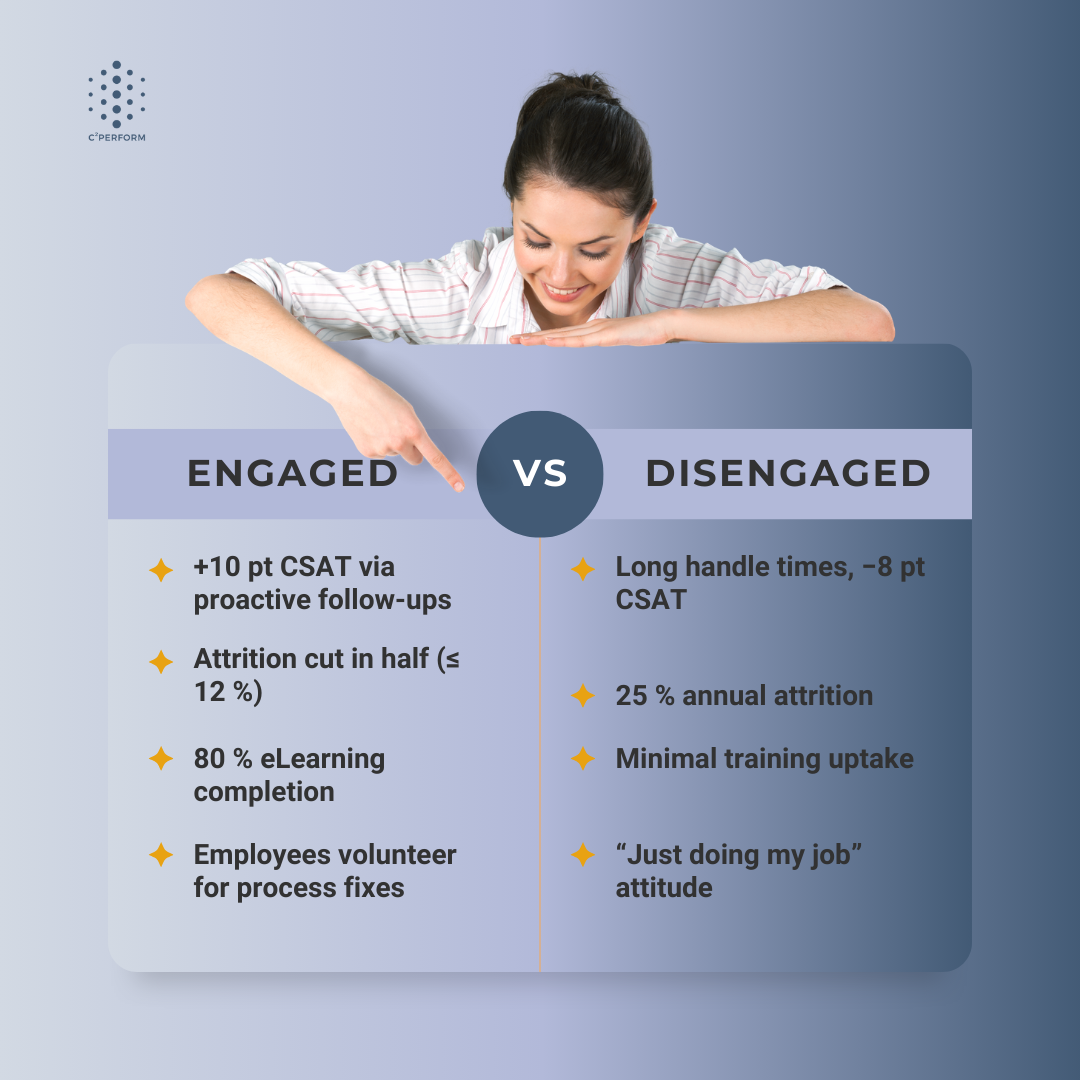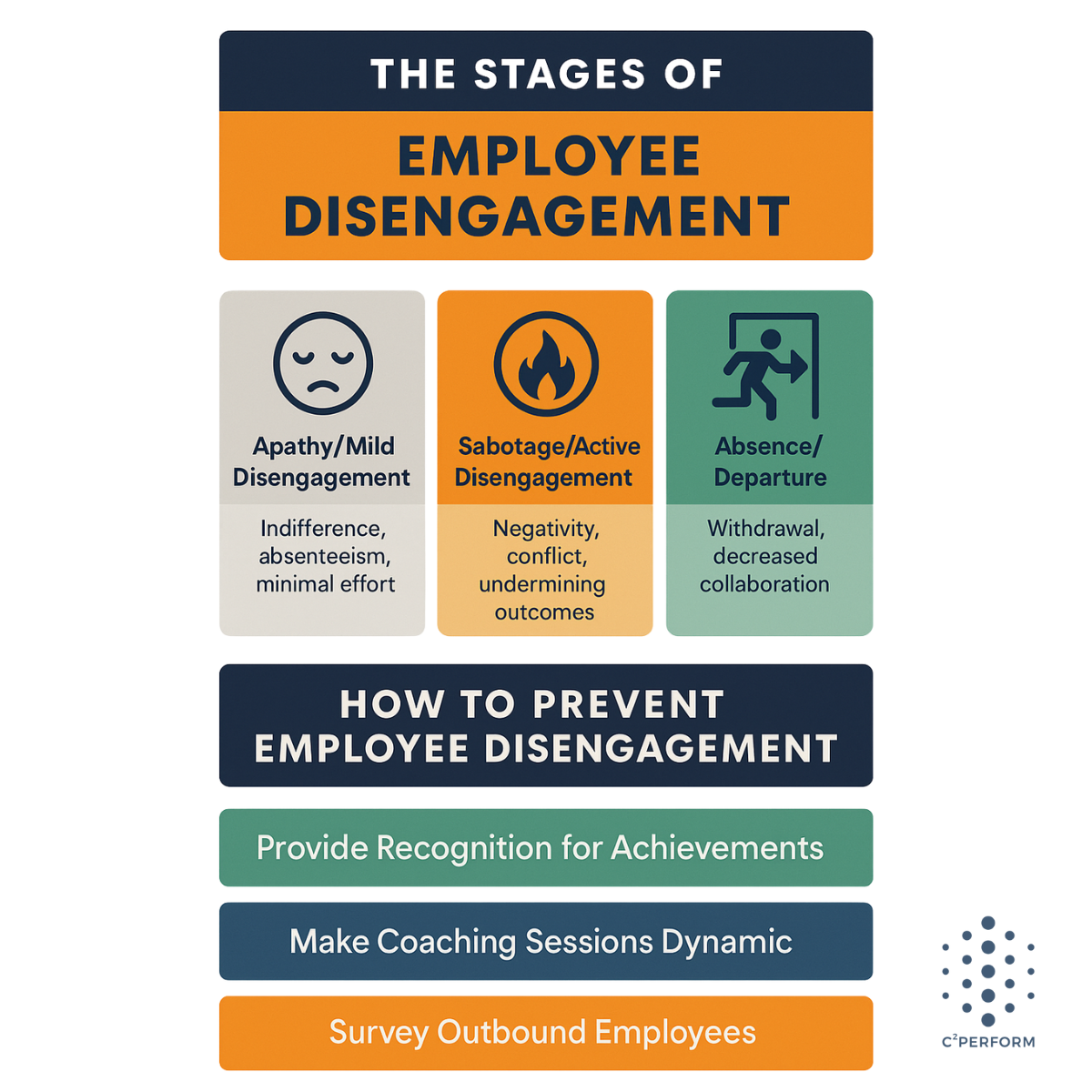In customer support operations, your metrics live or die with employee engagement. When people feel connected to their work, they go the extra mile, elevate customer experiences, and protect profit margins. When they don’t, absenteeism climbs, KPIs slide, and voluntary turnover spikes while employee performance takes a nosedive.
Let's take a deep dive into the stages of disengagement, why it happens, and—most importantly—how you can keep your team motivated.
What Is Employee Disengagement?
Disengagement is the emotional distance between an employee and their work. Gallup’s 2025 report shows global employee engagement fell to 21%, marking only the second recorded decline since 2009—highlighting a critical need for earlier intervention.
Employee disengagement can be described as the level of antipathy employees have towards their work or workplace. The more disengaged an employee is, the less likely they are to put in the effort needed to achieve results.
The habits of disengaged employees may vary depending on the severity of disengagement and the reasons behind it. For example, some leaders have reported things such as increased absenteeism, higher rates of voluntary turnover, reduced productivity, insubordination, and other issues with disengaged employees.

What Are the Common Root Causes of Employee Disengagement?
Why do employees become disengaged with work? The truth is, an employee might stop engaging with their work or even become actively hostile to their employers for any of the following reasons:
1. Lack of Employee Recognition
Employees crave timely, specific praise for hitting tough metrics or saving a customer relationship. When great work is met with silence, motivation dips and employee disengagement rises. A simple, public “thank-you” can reignite commitment faster than any incentive program.
2. Limited Career Growth Opportunities
Agents who see no clear path beyond today’s queue quickly tune out. Providing skill-building projects, certifications, and visible promotion tracks reduces turnover in contact centers and keeps high performers invested in long-term goals.
3. Toxic Work Environment & Poor Manager Relationships
Frequent conflicts, unmanaged stress, or micromanagement create a toxic workplace culture that drains morale. Coaching managers on empathetic feedback and facilitating open dialogue turns friction into collaboration—preventing disengagement before it spreads.
4. Non-competitive Compensation and Pay Inequity
When wages lag market benchmarks, employees feel undervalued and start job-hunting. Regular salary reviews and transparent bonus structures signal fairness, improving employee retention and protecting customer satisfaction scores.
5. Burnout from Overwork and Constant Stress
High call volumes, repetitive tasks, and scarce downtime push even top talent toward exhaustion. Rotating assignments, adding micro-learning breaks, and monitoring workload balance cut employee burnout and keep energy—and engagement—high.
Addressing these five triggers early helps transform “just-clocking-in” employees into proactive brand advocates who elevate every customer interaction.
The Stages of Employee Disengagement
There are many ways to break up the different stages of employee disengagement. Some define them as points along a process or workflow like the five stages of grief (denial, anger, bargaining, depression, and acceptance) while others sort them by level of severity.
We’ll focus on the level of severity to categorize the different stages of disengagement. It should be noted that these are broad categories and employees may not progress through every stage of disengagement listed in order.
Here are some descriptions of the different levels of disengagement and their symptoms.

Stage 1 – Apathy (Mild Disengagement)
According to Gallup’s latest findings, only 31% of employees in the U.S. and Canada are engaged—the lowest in three years—while the majority operate in a disengaged or neutral state.
-
Meet minimum targets, then clock out.
-
Skip optional events or training.
-
Limit interactions with managers or peers.
They rarely cause trouble, but they rarely innovate or delight customers either. Employees who stall in the same role, treat the job as short-term, or feel early burnout often land in this stage.
Stage 2 – Active Disengagement (Sabotage)
Actively disengaged employees hurt culture and KPIs. Warning signs include:
-
Chronic cynicism or eye-rolling in meetings.
-
Public criticism of leaders or process.
-
Deliberate shortcuts that jeopardize quality.
In rare cases, resentment escalates to policy breaches—data theft, vandalism, or misuse of customer information. Root causes usually tie back to perceived unfairness, poor manager relationships, or unresolved conflict.
Stage 3 – Absence & Departure
When work no longer feels worthwhile, disengagement tips into absenteeism and resignation. Look for these early cues:
-
Sudden PTO spikes or unexplained absences.
-
Silence in coaching sessions, ignored emails.
-
Withdrawal from team discussions—“eyes on the exit.”
Not every exit equals disengagement (career moves, retirement, life events), but unaddressed apathy or active resentment often leads here—taking hard-won expertise and customer relationships out the door. Identifying and reversing earlier stages can cut voluntary turnover dramatically.
How to Keep Employees Engaged
One thing that we’ve heard from a lot of managers and company leaders is that they have a lot of difficulty with preventing employee disengagement. Wondering how to deal with disengaged employees? One of the best ways is to prevent disengagement in the first place whenever possible.
There are countless articles on the web with tips for improving employee engagement and preventing friction in your teams. However, some may work better than others with different employees depending on their specific needs.
Here are a few things that some C2Perform clients have reported to us that work well for driving employee engagement and keeping team members both happy and productive:
1. Employee Recognition Programs That Matter
When daily wins become visible and valued, motivation shifts from short-term compliance to sustained commitment—creating a feedback loop that fuels discretionary effort.
-
Why it works: Acknowledging effort in real time triggers a dopamine boost that reinforces the behavior you want more of.
-
How to do it:
-
Track live KPIs—CSAT, first-call resolution, file accuracy—and tie them to instant shout-outs in a public feed.
-
Rotate rewards: digital badges, points toward an internal store, surprise half-days off.
-
Impact: One C2Perform client saw a 14-point lift in monthly engagement scores after implementing a badge-plus-leaderboard system linked to weekly team meetings.
2. Dynamic, Two-Way Coaching Sessions
Traditional “tell and fix” coaching stalls in today’s hybrid support world; a conversational, data-driven approach bridges the gap between manager intent and agent reality.
-
-
Open with a “win” from the the team member’s recent work
-
Ask for the employee’s take on blockers before offering guidance.
-
Align action items with the metrics they care about (e.g., handle-time reduction or empathy scores).
- Commit to follow up
3. Exit Interviews & Ongoing Pulse Surveys
Silent frustrations become costly churn; structured exit feedback and quick pulse checks turn departing voices into frontline intelligence you can act on today.
-
Why it works: Departing staff will tell you what current employees won’t—and pulse surveys catch small frustrations before they snowball.
-
How to do it:
-
Use structured exit surveys with rating scales and open-ended questions about culture, tools, and leadership.
-
Run monthly micro-surveys (one or two questions) to track morale trends in real time.
-
Impact: After acting on exit-survey feedback about outdated scripts, a finance-sector support team shaved 30 seconds off AHT and reduced new-hire turnover by 18 %.
C2Perform Is Your Employee Engagement Partner
At C2Perform, we believe engagement isn't a box to check—it’s a system to build, sustain, and evolve. Discretionary effort, coaching effectiveness, retention, and frontline resilience all start with the habits and culture you create day by day.
That’s why we designed C2Perform as more than just another point solution: it’s a unified platform where recognition, coaching, communication, learning, and quality assurance work together—seamlessly, intuitively, and measurably.
We’ve spent the past decade partnering with contact centers and support teams across 30+ countries, helping them move beyond short-term fixes to create real, lasting engagement. Our tools are shaped by what real-world teams need: simple, actionable workflows that empower agents, lift KPIs, and align operations with business goals.
If you're ready to transform how your team connects, performs, and grows, we’d love to explore what’s possible together. Book a Discovery Call and let’s reimagine what great employee engagement looks like for your organization.
 English
English Español
Español







.png?height=350&name=Untitled%20(300%20x%20175%20px).png)



